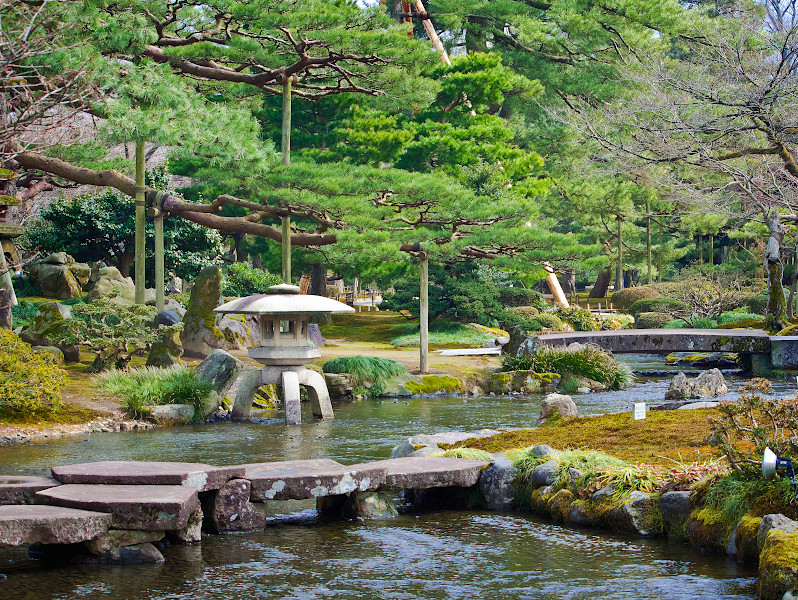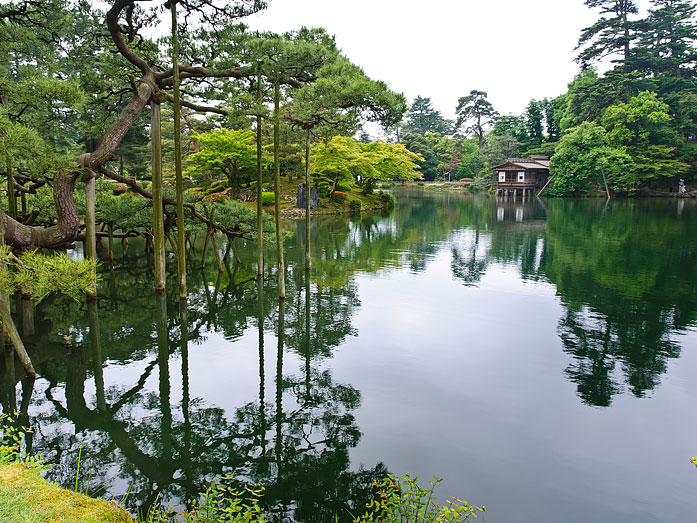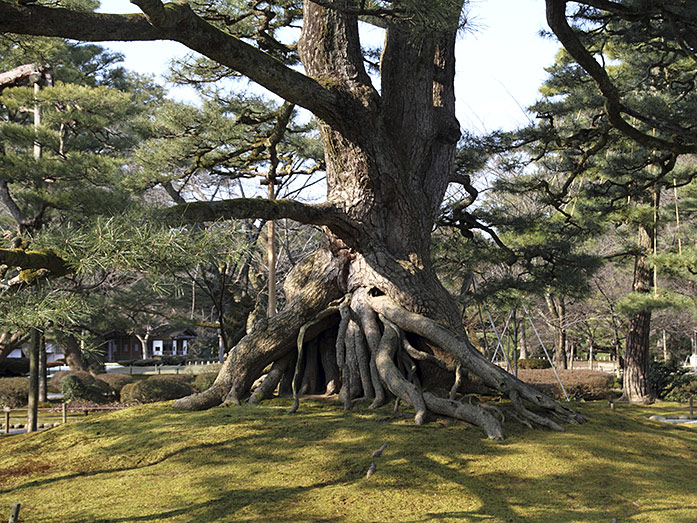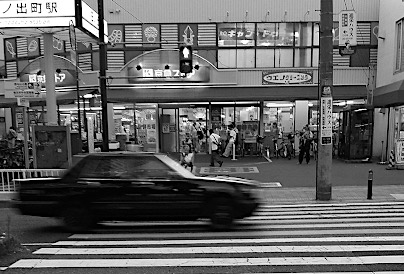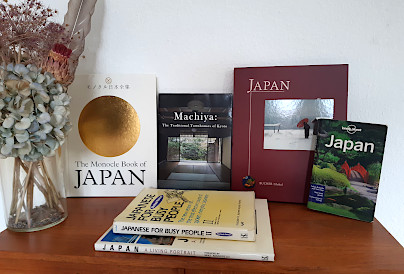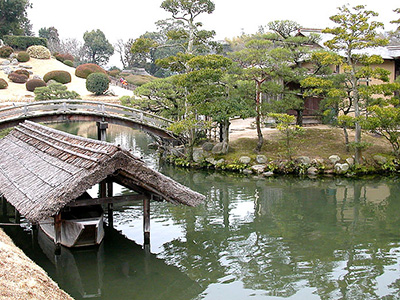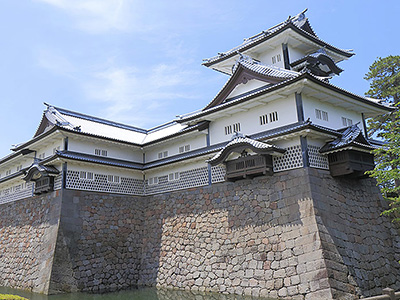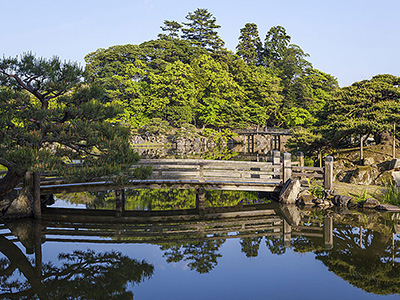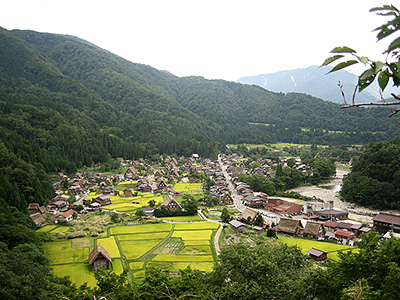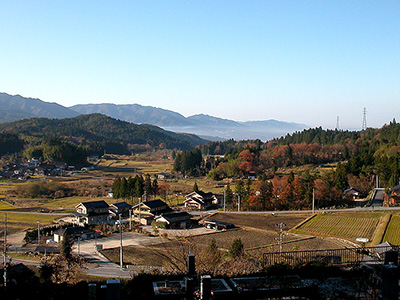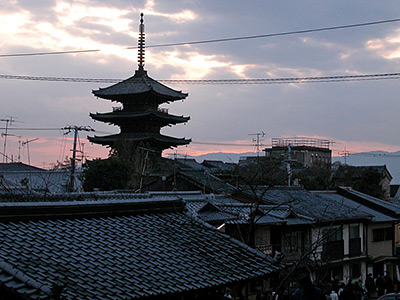Kenrokuen Garden in Kanazawa
This post can contain affiliate links, which means that we may receive a small commission if you make a purchase using these links.
Facts & Figures
Kenrokuen Garden in the city Kanazawa belongs to the Three Most Beautiful Landscape Gardens in Japan, besides the Kairakuen Garden in Mito and the Korakuen Garden in Okayama. Kenrokuen covers an area of nearly 114500 square meters (25 acres). You will find there beautiful ponds, fountains, streams, seasonal flowers, trees, waterfalls, bridges, statues and traditional tea houses.
 Buy now and Save >
Buy now and Save >
Since 2004 I have traveled nearly every year to Japan. The rail pass made my life easier to discover all those amazing places in my favorite country.
The name of the garden means - garden of six elements. A Chinese poem describes the must-have features of a truly outstanding garden like: huge open space - seclusion, artifice - old style elegance, water streams - panoramic views. Kenrokuen combines all these elements, which is really unique. Interesting fact to avoid the breaking of branches from pine trees during the heavy snowfalls in winter rope umbrellas (yukitsuri) are installed. These installations are a very popular sight for tourists. Kenrokuen is worth a visit during every season of the year.
- Kenrokuen Garden:
- Opening Hours - 7:00 am to 6:00 pm – 1st of March till 15th of October
- Opening Hours - 8:00 am to 5:00 pm – 16th of October till 28th of February
- Admission Fee - Adults (over 18): 300 yen, Children (6 -18): 100 yen
My tips for local activities
Explore the best parts of Kanazawa with a local guide. The tour can take 4 or 6-hours. Check out this page > for more details.
History
Kenrokuen Garden was created by the ruling Maeda family between 1620s till the 1840s. It used to be the smaller private outer garden of the nearby Kanazawa Castle and was called by then Renchi-tei garden. A fire destroyed the Kenrokuen Garden in 1759. The restoration took till 1774 under the order of the 11th Lord Harunaga (1745 – 1810). In 1822 Lord Matsudaira Sadanobu (1759 - 1829) made the decision to rename the place Kenroku-en. The garden was not open for the public until 1874. Kenroku-en received the status of a National Site of Scenic Beauty in 1922 and in 1985 the status of a National Site of Special Scenic Beauty. In 2000 the once destroyed tea houses Shigure-tei and Funano-ochin were reconstructed.
Location

The Kenrokuen Garden is located outside the gates of Kanazawa Castle. The city Kanazawa is located within the Ishikawa Prefecture.
Address: 1-4 Kenrokumachi, Kanazawa-shi, Ishikawa-ken
How to get to Kanazawa?
- 4hrs from Tokyo to Maibara by JR Tokaido Shinkansen and limited express to Kanazawa
- 7-8hrs from Tokyo to Kanazawa by Willer Express highway bus
How to get to Kenrokuen Garden?
- 15min from Kanazawa Station to Kenrokuen-shita bus stop by Hokutetsu bus
Sightseeing spots within Kenrokuen Garden
Top:
Seisonkaku villa - This house, also called Tatsumigoten, was used by the wives of the Maeda clan.
Midori waterfall - The waterfall is 6.6 meters high and 1.6 meters wide and pouring into the Hisago-ike pond. It was created in 1774.
Yugao-tei tea house - The tea house is located at the Hisago-ike pond and was built in 1774. It is the oldest structure in the garden.
Kaiseki-to lantern - The 4.1 meter high stone pagoda is located on a small island at the centre of the Hisago-ike pond.
Kasumiga-ike pond - The pond is located at the center of Kenrokuen Garden and covers an area of 5800 square meters.
Fountain - The oldest naturally-powered water fountain in Japan can be found near Kasumiga-ike. It is a really impressive sight with its height of 3.5 meters. The water comes from the nearby Saigawa River.
Neagari Matsu - The black pine was planted by the 13th Lord Maeda Nariyasu (1811 – 1884) himself. The shape of the pine and its roots are really unique.
Uchihashi-tei tea house - The building is dating back to 1776. Tea ceremonies are held here once a year on 7th of May.
Matsuo Basho memorial stone - Famous haiku poet Matsuo Basho (1644 – 1694) visited the garden in Kanazawa in 1689. The poem he wrote here can be found on this stone.
Meiji Memorial - The 5m tall bronze statue was created in 1880 to honour the deaths of 400 soldiers during a battle (Satsuma Rebellion, 1877 - 1878) in Kyushu. The red pine trees planted besides the monument came from Higashi-Honganji and Nishi-Honganji temples in Kyoto.
Kotoji-toro Lantern - The famous stone lantern with two uneven legs is a must see during your visit. It is the symbol of Kenrokuen and the city Kanazawa. The name Kotoji came from the instrument Koto (Japanese harp), which has special shapes resembling the uneven legs of the lantern.
Plum-Grove Garden - The plum-grove is located in the older part of the garden. It contains approximately 200 plum trees of 20 different varieties.
Hanami Bashi (Flower Viewing Bridge) - This ancient bridge is one of the most scenic spots in the garden and very popular for taking pictures.
Ganko-bashi (Flying Geese Bridge) - This stone bridge has the unique shape of a flying flock of geese.
Yamazaki yama and Sazae yama - These two little hills offer nice views over the property.
Festival & Events (dates can change without notice)
February
Winter Light-Up at Kenrokuen Garden (28th - 5th)
Enjoy the illumination of the garden till 9pm.
April/May
Kenrokuen Garden's beautiful illumination during cherry blossom period (28th - 11th)
The garden is illuminated from 6pm to 9:30pm.
June
Hyakumangoku Matsuri (last 3 days, peak first Saturday in June)
The Hyakumangoku Matsuri is the largest and most famous annual festival of the city Kanazawa and the Ishikawa Prefecture. Absolute highlight is the magnificent Hyakumangoku Parade, which takes place during the festival from Kanazawa Station to Kanazawa Castle Park. It is attracting large crowds of tourists and locals. The matsuri commemorates the entry of Lord Maeda Toshiie in 1583 into Kanazawa Castle.
Where to stay in Kanazawa?
My 100 Best Moments in Japan
I have visited Japan nearly every year since 2004. This is my collection of the 100 best moments in my favorite country. Enjoy the pictures and I hope you will start your own journey soon.
Find out more >
Books about Japan
Reading books is a great source of inspiration for me. Check out my recommended list of books about the fascinating country Japan.
My Book recommendations >

